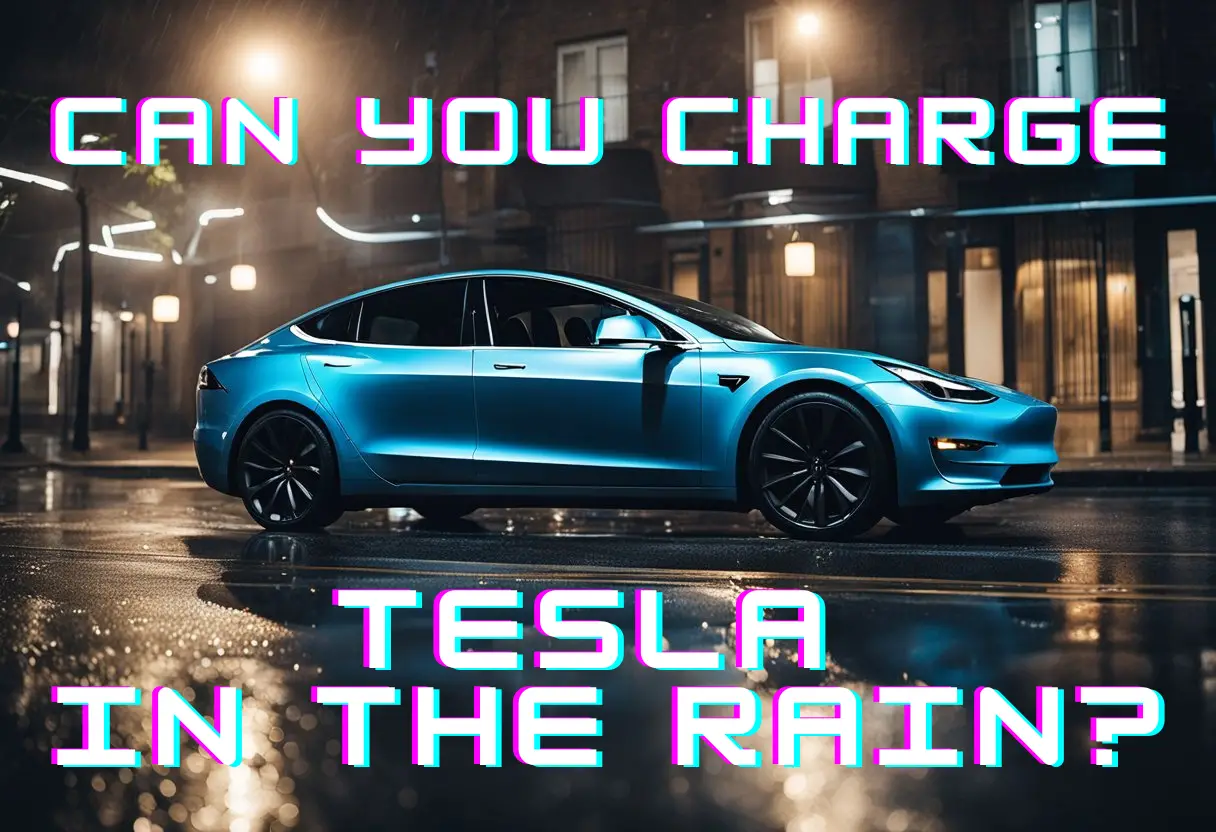If you’re a Tesla owner, you might be wondering if it is safe to charge your car in the rain. After all, water and electricity don’t mix, and you don’t want to risk damaging your expensive vehicle. The good news is that you can charge your Tesla in the rain, but there are some precautions you should take to ensure that everything goes smoothly.
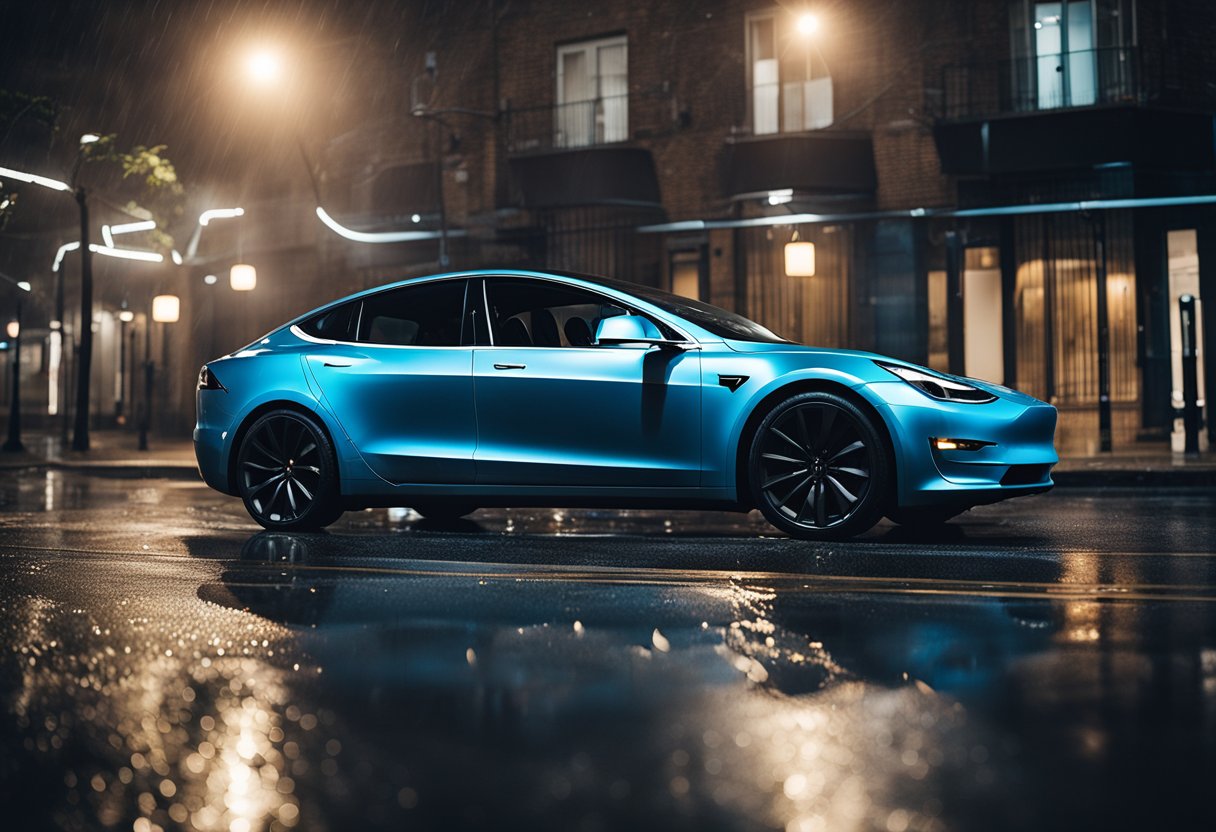 Before we dive into the details of charging your Tesla in the rain, let’s take a quick look at how Tesla charging works. Tesla vehicles are powered by lithium-ion batteries, which are charged using electricity. To charge your Tesla, you’ll need to connect it to a charging station or wall connector using a charging cable. The charging cable is then plugged into the charging port on your Tesla, which is located on the driver’s side of the vehicle.
Before we dive into the details of charging your Tesla in the rain, let’s take a quick look at how Tesla charging works. Tesla vehicles are powered by lithium-ion batteries, which are charged using electricity. To charge your Tesla, you’ll need to connect it to a charging station or wall connector using a charging cable. The charging cable is then plugged into the charging port on your Tesla, which is located on the driver’s side of the vehicle.
When charging your Tesla in the rain, safety should be your top priority. Water and electricity don’t mix, and charging your Tesla in wet conditions can be dangerous if you’re not careful. However, Tesla has taken steps to ensure that their vehicles are safe to charge in the rain. Tesla charging cables and ports are designed to be waterproof, and all Tesla vehicles have safeguards in place to prevent water-related charging issues.
Table of Contents
Key Takeaways
- You can charge your Tesla in the rain, but you need to take precautions to ensure safety.
- Tesla charging cables and ports are designed to be waterproof.
- Tesla vehicles have safeguards in place to prevent water-related charging issues.
Understanding Tesla Charging
Charging a Tesla is a simple process that involves plugging the vehicle into a charging port and supplying it with electricity. A Tesla can be charged using a variety of charging equipment, including a Tesla Wall Connector, a Supercharger, a mobile connector, or a standard cable.
Tesla Charging Port
The charging port of a Tesla is located on the driver’s side of the vehicle, near the rear wheel. It is covered by a small door that can be opened by pressing a button on the charging cable. When the charging cable is plugged into the charging port, the vehicle begins to charge.
Charging Equipment
The Tesla Wall Connector is a home charging solution that can be installed in a garage or outside the home. It provides a faster charging rate than a standard cable and can be used to charge a Tesla overnight. Superchargers are high-speed charging stations that can charge a Tesla in as little as 30 minutes. They are typically found along major highways and in urban areas.
Charging Cables
Charging cables are used to connect the charging equipment to the Tesla. They come in different lengths and can be used with different types of charging equipment. The Tesla Wall Connector and Supercharger come with their own charging cables, while the mobile connector and standard cable can be purchased separately.
Cover
It is important to keep the charging port of a Tesla covered when not in use. This helps to protect it from the elements and prevents dirt and debris from entering the port. Tesla provides a charging port cover that can be used to cover the port when it is not in use.
Charging Voltage
The charging voltage of a Tesla depends on the type of charging equipment being used. The Tesla Wall Connector and Supercharger provide a higher charging voltage than the mobile connector and standard cable. It is important to use the correct charging equipment for your Tesla to ensure that it is charged safely and efficiently.
Can You Charge a Tesla in the Rain?
Yes, you can charge a Tesla in the rain. However, it is important to take precautions to prevent water from entering the charging port or the charging equipment.
Using a waterproof cover for the charging port and a waterproof box for the charging equipment can help to keep them dry. It is also important to ensure that the charging cable is not lying in a puddle of water.
In summary, charging a Tesla is a simple process that can be done using a variety of charging equipment. It is important to keep the charging port covered when not in use and to use the correct charging equipment for your Tesla. Charging a Tesla in the rain is possible, but precautions should be taken to prevent water from entering the charging equipment.
Safety Precautions and Risks
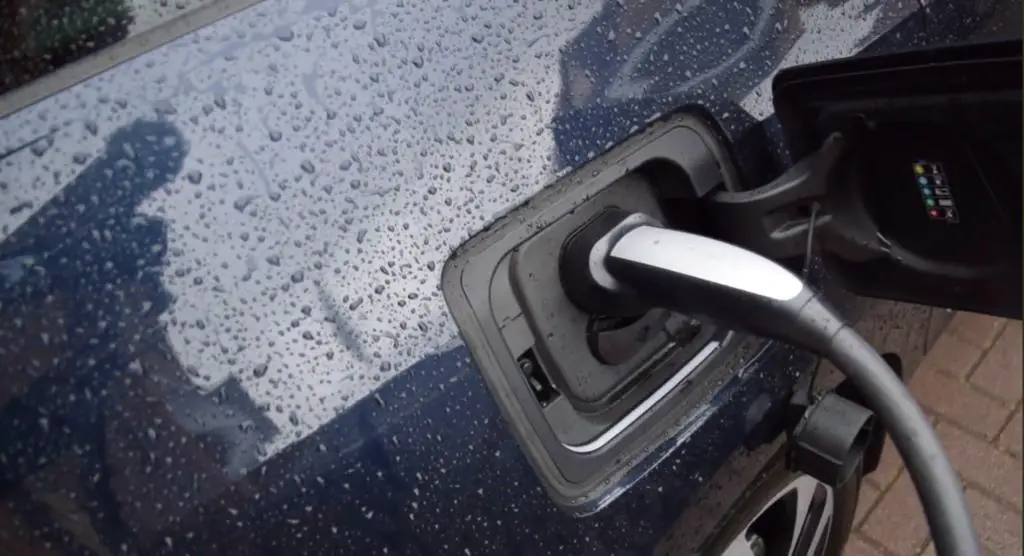
Charging your Tesla in the rain requires some safety precautions to avoid any risks. Water and electricity do not mix, making it important to take extra safety measures when charging your Tesla in the rain. Here are some safety precautions to keep in mind:
Use a Waterproof Connection Box
To prevent water from getting into your Tesla’s charging port, you should use a waterproof connection box. This will protect the charger components and connections from getting wet. You can find waterproof connection boxes at most hardware stores or online.
Avoid Charging in Inclement Weather
It’s best to avoid charging your Tesla in inclement weather. If it’s raining heavily or there is a risk of lightning, it’s best to wait until the weather clears up. Charging your Tesla during a thunderstorm can increase the risk of electric shocks.
Use a Waterproof Box
Another safety precaution is to use a waterproof box when charging your Tesla in the rain. This will keep your charger components and connections from getting wet. You can find waterproof boxes at most hardware stores or online.
Check for Safety Features
Tesla has built-in safety features to detect if water has gotten into the charging port and compromised the charging connection. If water gets in, the vehicle will immediately stop the flow of power to avoid any damage to the car. However, it’s still important to take safety precautions to avoid any risks.
Avoid Plugging in Wet Connectors
If the charging port or connector is wet, do not plug it in. This can increase the risk of electric shocks. Wait until the connector and charging port are dry before plugging in your Tesla.
Keep a Safe Distance
When charging your Tesla in the rain, keep a safe distance from the charging port and connector. This will prevent any water from splashing onto the charging port and connector, reducing the risk of electric shocks.
Overall, charging your Tesla in the rain requires extra safety precautions to avoid any risks. Use a waterproof connection box and box, avoid charging in inclement weather, and check for safety features to keep yourself and your Tesla safe.
Weather Impact on Charging
When it comes to charging your Tesla in wet weather conditions, there are a few things that you should keep in mind. While Teslas are designed to be weatherproof, it’s still important to exercise caution when charging your vehicle in the rain, snow, or during a thunderstorm.
One of the biggest concerns with charging in wet weather is the potential for water to enter the charging port. While most Teslas have safeguards in place to prevent this from happening, it’s still a good idea to wipe down the charging port before plugging in your vehicle. This will help to ensure that there is no moisture or debris on the charging port that could interfere with the charging process.
Another thing to keep in mind is that severe weather conditions, such as thunderstorms or lightning strikes, can sometimes cause power outages that can disrupt the charging process. If you live in an area that is prone to severe weather, it’s a good idea to have a backup plan in place in case your power goes out while you’re charging your Tesla.
Cold weather can also impact the charging process, as EVs can experience range loss and slower charging in colder temperatures. It’s important to be aware of this and plan accordingly, especially if you live in an area with particularly cold winters.
Overall, while charging your Tesla in wet weather conditions is generally safe, it’s important to exercise caution and be aware of the potential risks. By taking the necessary precautions and planning ahead, you can ensure that your Tesla stays charged and ready to go no matter what the weather may bring.
Charging Efficiency and Battery Life
When charging your Tesla in the rain, you may be concerned about the charging efficiency and the battery life of your vehicle. Charging efficiency refers to how much energy is lost during the charging process, while battery life refers to the overall lifespan of your battery.
Fortunately, charging your Tesla in the rain will not affect the charging efficiency or the battery life of your vehicle. Tesla vehicles are designed to withstand different weather conditions, including rain. However, it is important to ensure that you are charging your vehicle safely, as water and electricity can be a dangerous combination.
To ensure that your Tesla is charging efficiently, it is recommended that you use a high-quality charger and plug it into a dedicated circuit. This will help to prevent any power surges or fluctuations that could damage your battery.
In addition, it is important to recalibrate your Tesla battery periodically to maintain its optimal performance. This can be done by charging your battery to 100% and then letting it discharge to around 10%. Repeat this process a few times to recalibrate your battery.
Finally, it is important to note that all batteries degrade over time, regardless of whether they are charged in the rain or not. However, Tesla batteries are known for their longevity and can last for many years with proper care and maintenance.
Overall, charging your Tesla in the rain is safe and will not affect the charging efficiency or battery life of your vehicle. Just be sure to follow the recommended safety precautions and take good care of your battery to ensure that it lasts for many years to come.
Additional Considerations
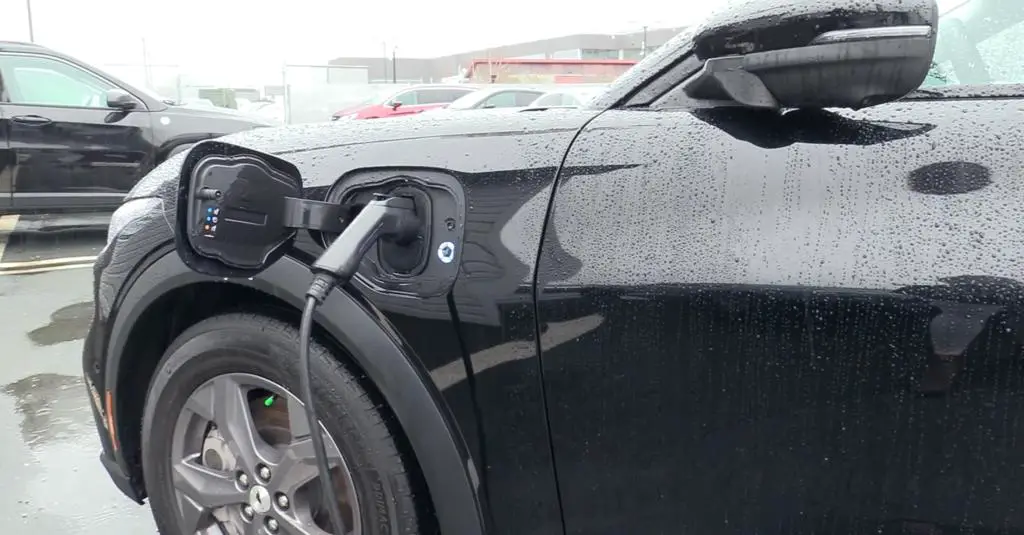
When charging your Tesla in the rain, there are a few additional considerations to keep in mind to ensure safety and maintain the longevity of your vehicle.
Outdoor Use
If you are charging your Tesla outdoors, it is important to make sure that the charging cable and connectors are not exposed to water. Use a waterproof box to protect the charger components and connections from getting wet. Consider using a waterproof cover for the charging port to keep out water.
Extension Cords
It is not recommended to use an extension cord to charge your Tesla. Extension cords can cause voltage drops and increase the risk of electrical fires. If you must use an extension cord, make sure it is rated for high voltage and is properly grounded.
High Voltage
When charging your Tesla, you are dealing with high voltage. It is important to take proper precautions and follow all safety guidelines outlined in your driver’s manual. If you are not comfortable handling high voltage, consider hiring a licensed electrician to install a dedicated charging outlet in your garage.
Charging Issues
If you experience any charging issues, such as the charging port not opening or the vehicle not charging, refer to your driver’s manual for troubleshooting tips. If the issue persists, contact Tesla customer support for assistance.
Corrosion
Exposure to water can cause corrosion on the charging connectors and other components of your Tesla. To prevent corrosion, wipe down the charging connectors with a dry cloth after each use.
Tesla Supercharger
Tesla Superchargers are designed to be used in all weather conditions, including rain. However, it is important to follow all safety guidelines and properly plug in the charging cable to ensure a secure connection.
Charging Capabilities
Your Tesla has a maximum charging rate, which is determined by the charging equipment and the current available. If you are charging your Tesla in the rain, make sure the charging equipment is capable of delivering the necessary current.
Warranty
If you experience any issues with your Tesla due to charging in the rain, refer to your warranty for coverage information. Make sure to follow all safety guidelines outlined in your driver’s manual to avoid voiding your warranty.
Frequently Asked Questions
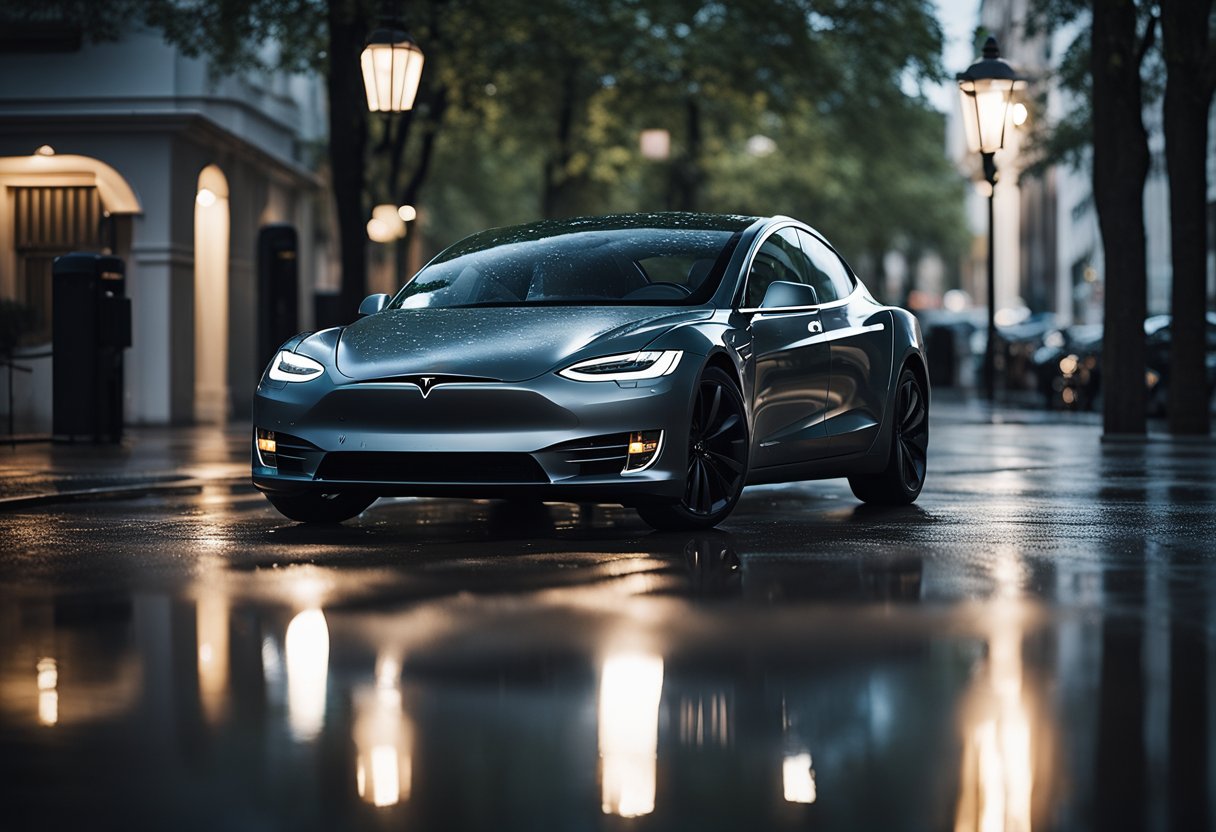
Can you charge your Tesla in the rain?
Yes, you can charge your Tesla in the rain. However, it is important to take some precautions to ensure that you are charging your vehicle safely.
All Teslas are designed to withstand different weather conditions, and that includes charging them during a rainstorm. In case you are concerned about the safety implications and technical considerations surrounding charging electric vehicles in wet conditions, you can refer to the relevant article for more information.
Is the Tesla mobile connector waterproof?
The Tesla mobile connector is not completely waterproof. It is designed to be water-resistant, which means it can withstand some water exposure but not complete immersion.
It is important to ensure that you do not expose the mobile connector to excessive water or moisture. If you plan to charge your Tesla in the rain, you should use a waterproof box to keep your charger components and connections from getting wet.
Can the Tesla charging cord get wet?
The Tesla charging cord is designed to withstand some exposure to water, but it is not completely waterproof. It is important to avoid exposing the charging cord to excessive water or moisture. If you plan to charge your Tesla in the rain, you should use a waterproof cover for the charging port to keep out water.
Does weather affect Tesla charging?
Weather conditions can affect the charging time of your Tesla. Extremely cold temperatures can cause the battery to drain faster, while extremely hot temperatures can reduce the battery’s capacity. However, Tesla vehicles are designed to operate in a wide range of weather conditions, and you should not experience any issues charging your Tesla in the rain.
Are Teslas safe to use in the rain?
Yes, Teslas are safe to use in the rain. However, it is important to ensure that you take the necessary precautions to avoid any water-related issues.
Make sure you use a waterproof box when charging in the rain to keep your charger components and connections from getting wet. You should also consider using a waterproof cover for the charging port to keep out water.
Can you leave your Tesla charger outside?
Yes, you can leave your Tesla charger outside. However, it is important to ensure that you take the necessary precautions to protect it from the elements.
If you plan to leave your Tesla charger outside, you should use a weatherproof cover to protect it from rain, snow, and other weather conditions. You should also ensure that the area where you plan to leave your charger is safe and secure.
